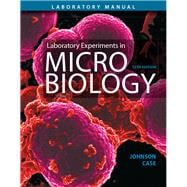For general microbiology laboratory courses
Laboratory Experiments in Microbiology features 57 thoroughly class-tested and easily customizable exercises that teach basic microbiology techniques and applications. The manual provides comprehensive coverage of every area of microbiology across diverse disciplines, including the biological sciences, allied health sciences, agriculture, environmental science, nutrition, pharmacy, and various pre-professional programs. The lab manual is the perfect companion to Tortora/Funke/Case’s Microbiology: An Introduction, 13th Edition or any introductory microbiology text.
The 12th Edition of Laboratory Experiments in Microbiology is easier than ever to navigate and more visually effective with new icons indicating when an exercise addresses the human or environmental microbiome, is investigative, or addresses an ASM guideline. New ASM Thinking Skills outline the steps that help develop laboratory thinking skills. Pre-lab quizzes in Mastering™ Microbiology ensure students arrive prepared for each lab, and activities such as Lab and Lecture: Putting It All Together help students see how lab and lecture are integrated.










